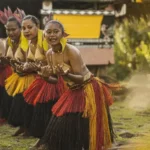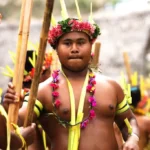Tuvalu, a small Polynesian island nation located in the Pacific Ocean, is home to a vibrant culture deeply connected to its natural surroundings. Its traditional clothing reflects the islanders’ harmonious relationship with their environment and their cultural heritage.
Though modern influences have become more prominent in daily attire, traditional clothing continues to play an essential role in ceremonies and cultural identity.
Origins and Cultural Significance of Traditional Clothing in Tuvalu
The traditional clothing of Tuvalu is rooted in the islanders’ reliance on natural resources, such as pandanus leaves, coconut fibers, and shells, for crafting garments and accessories. These materials not only reflect the environment but also carry symbolic significance, often used to represent social status, family lineage, or tribal affiliation.
Clothing in Tuvalu is not merely functional; it embodies artistry, craftsmanship, and spiritual meaning. From ceremonial attire to daily wear, the styles and materials tell stories of the islanders’ lives, beliefs, and connection to their surroundings.
See also Traditional clothing in Palau
Traditional clothing in PalauKey Elements of Traditional Tuvaluan Clothing
Tuvaluan traditional clothing varies in complexity depending on the occasion. Here are some of the most notable elements of their attire:
Lavalava (Sarong)
The lavalava is the most iconic garment in Tuvalu. It is a versatile wrap-around cloth that can be worn by both men and women. Traditionally, lavalavas were handmade using local materials and featured vibrant patterns or natural dyes. Modern versions are often brightly colored and decorated with Polynesian motifs.
- 👗 Women’s Lavalavas: Women typically wear longer lavalavas paired with tops or adorned with flowers for formal events.
- 🩳 Men’s Lavalavas: Men wear shorter versions, often accompanied by belts or sashes during traditional dances or ceremonies.
Woven Mats and Skirts
Women frequently wore skirts made from woven pandanus leaves or other plant fibers. These skirts were intricately designed, sometimes dyed in earthy tones, and were reserved for special events like weddings or cultural performances.
- The crafting of these skirts is a communal activity, showcasing the skills passed down through generations.
🌺 Accessories and Adornments
Traditional clothing is often complemented with accessories such as:
See also Traditional clothing in Micronesia (Federated States of Micronesia)
Traditional clothing in Micronesia (Federated States of Micronesia)- Floral garlands (Lei): Worn around the neck or head to signify celebration or welcome.
- Shell Jewelry: Necklaces, bracelets, and anklets crafted from seashells and coral, highlighting the maritime culture of Tuvalu.
- Coconut Fiber Belts: These belts, sometimes adorned with shells or feathers, are an integral part of ceremonial attire.
Regional Variations in Traditional Clothing
While Tuvalu consists of nine islands, subtle regional differences exist in traditional attire. The variations often reflect the availability of resources and unique local customs. For example:
- Outer Islands: Communities in outer islands like Niutao or Nanumea often emphasize more natural and earthy styles, relying heavily on pandanus weaving for daily garments and ceremonial dress.
- Funafuti (Capital): In Funafuti, modern influences merge with traditional styles, resulting in a mix of traditional pandanus mats with more contemporary fabrics during festivals.
Traditional Clothing in Ceremonial and Festive Contexts
Ceremonies and festivals in Tuvalu are vibrant occasions where traditional clothing takes center stage. Some notable events include:
Weddings
During weddings, brides often wear elaborately woven pandanus skirts paired with floral adornments and coconut-fiber belts. The groom’s attire typically consists of a decorative lavalava and shell jewelry. The outfits symbolize unity, prosperity, and respect for cultural heritage.
Fatele (Traditional Dances)
Fatele, Tuvalu’s traditional dance, is a significant cultural expression where clothing plays an important role. Performers wear brightly colored lavalavas, flower garlands, and anklets to enhance their movements. The rhythmic swaying of pandanus skirts adds a mesmerizing visual element to the performance.
Community Gatherings
During communal events, attendees often showcase their finest traditional attire to celebrate unity and shared heritage. These gatherings provide an opportunity to honor ancestral customs through clothing and storytelling.
The Influence of Modernity on Tuvaluan Clothing
Like many island nations, Tuvalu has experienced globalization, which has introduced modern fabrics and styles. Imported clothing, such as t-shirts and Western-style skirts, is now common for everyday wear. However, traditional clothing remains deeply valued for its cultural significance, particularly during special occasions.
Tuvaluan artists and designers are also working to preserve traditional practices by blending ancient techniques with modern designs. This fusion not only sustains cultural heritage but also attracts global attention to Tuvalu’s unique identity.
Challenges in Preserving Traditional Clothing
Preserving traditional clothing in Tuvalu faces several challenges, including:
- Environmental Factors: Rising sea levels and changing climates affect the availability of natural resources like pandanus and coconut trees.
- Cultural Erosion: The younger generation’s inclination toward Western styles risks diminishing interest in traditional attire.
- Limited Resources: As a small nation, Tuvalu has limited access to funding for cultural preservation programs.
Efforts to overcome these challenges include educational initiatives, community workshops on traditional weaving techniques, and cultural festivals that celebrate Tuvaluan heritage.
Traditional Clothing as a Symbol of Tuvaluan Identity
Traditional clothing in Tuvalu serves as a bridge between past and present, reflecting the nation’s enduring connection to its environment and cultural roots. These garments are not merely decorative; they are profound expressions of identity, resilience, and pride.
By cherishing and preserving their traditional attire, Tuvaluans honor their ancestors and ensure their heritage thrives for generations to come.
